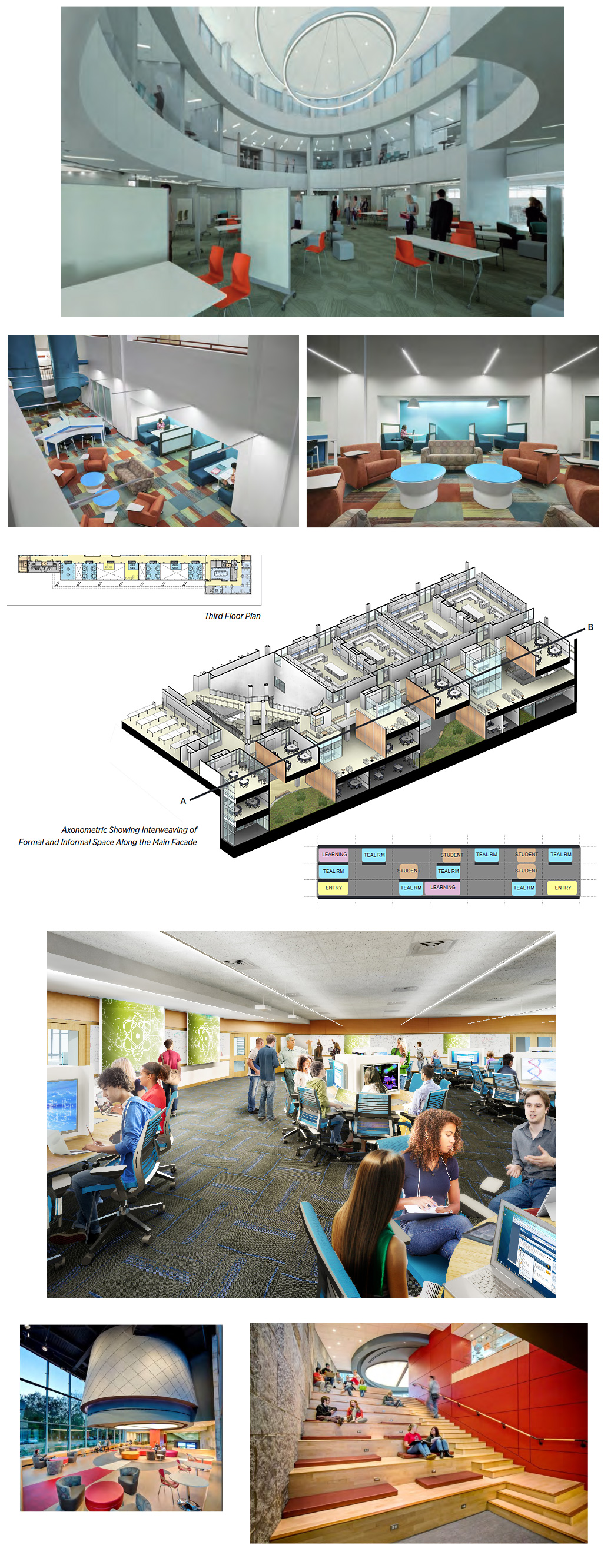Excerpt from the Learning Spaces Collaboratory Roundtable | Spring 2016: Focusing on the Future of Planning Learning Spaces | Boston University
Also see this PDF file.
Driving Questions
- How can we promote active learning environments—in classrooms and in teaching labs? What does it take to promote small group peer-to-peer interaction and learning?
- How can spaces promote investigative, cross-disciplinary problem-based learning and problem-solving?
- What does a ‘technology-rich’ learning environment mean? What are the tools needed in learning spaces to prepare students for increasing technology-dependent careers. How many ways and places can technologies be used in a facility to serve the campus community as well as to support outreach beyond the campus?
- In our planning, how can we exploit opportunities for sharing, breaking down departmental silos? How can we maximize the use of flexible or case method classrooms, student study, break-out space, and shared administrative space? Does it work to distribute disciplines throughout the building rather than to cluster them by floor? What needs to be next to what?
- How can a goal of increasing lower division student success in STEM disciplines be addressed in the planning process? What does it take to attract students to these fields and motivate them to persist? How do we create a supportive environment conducive to success?
- How do our spaces reflect the social nature of learning, the need for collegiality, the unplanned interactions and conversations that shape and nurture communities?
Other Driving Questions
- What can the design of the building do to promote a culture of innovation in academic programs?
- How will students and faculty interact in this building, and how are team based collaborations supported within and outside of formal instruction times?
- How can we design for the future and encourage innovation and new ways of learning?
- How do we create an environment of entrepreneurial thinking, with the vibrancy and experimentation atmosphere of the West coast combined with the structure and richness of the Northeast academic history?
- How can we create awareness, connections and encourage collaboration through our architecture?
- How do we capture the “Maker” experience of rapidly prototyping ideas in a non-STEM building?
- How essential is territorialization in a dynamic, academic environment, and what are the boundaries that should be defined by the
physical environment?
.
Since Bryant has been experimenting with rapidly adaptable learning environments, through recent campus renovations, the AIC project benefited from lessons learned, including:* Maximize clear structural dimensions to facilitate combining adjacent rooms if larger spaces are needed in a few years.
* Make all tiers in classrooms easily removable to switch to flat floor environments if desired.
* Maximize writing surfaces throughout the building.
* Limit the negative impact of technology by creating spaces that encourage low-tech human interaction and promote hands on mapping of strategies and ideas
Other Driving Questions
- To enhance the educational experience, specifically for a large student population, what elements need to be considered in planning a learning community?
- How have technological advances in the science workplace changed the design of the undergraduate curriculum? How does this reshape space for different types of learning?
- How does the need for safety and efficiency drive operations and space planning?
- How do we create a welcoming environment and flexible learning spaces? How big is too big?
- How do we rigorously and responsibly plan for an unknown future?
- To support student success, what elements and adjacencies should an institution/design team consider for an academic building?









